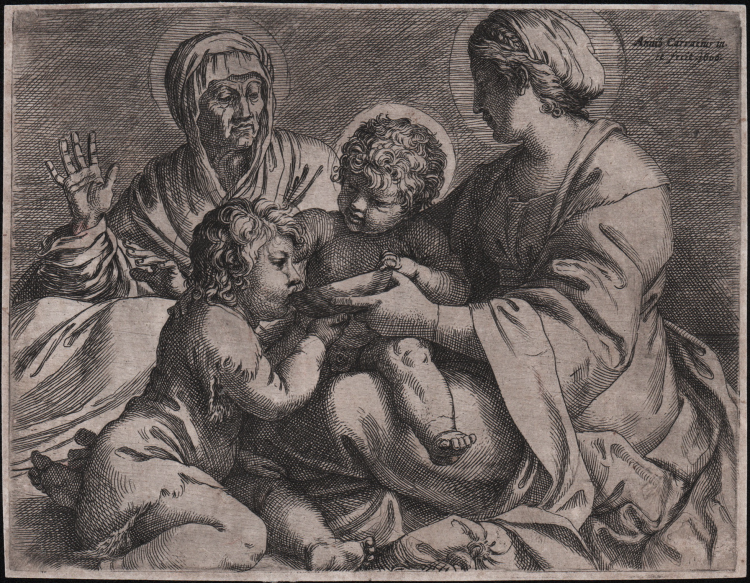




| Reference: | S42689 |
| Author | Annibale CARRACCI |
| Year: | 1606 |
| Measures: | 165 x 130 mm |



| Reference: | S42689 |
| Author | Annibale CARRACCI |
| Year: | 1606 |
| Measures: | 165 x 130 mm |
Etching and engraving, lettered within image at top right corner: 'Annib. Carracius in. / et fecit. 1606.' Example in the second state, of three, before di N. Van Aelst excudit.
A fine impression, printed on contemporary laid paper, with narrow margins, very good condition.
This is the first known print by Annibale made after 1600 and where the stylistic change from his last work (The Drunken Silenus, 1600) is evident: the figures are simpler, almost geometric in shape, and there is an accentuation of the strong contrasts of light and shadow, together with a plastic effect. The preparatory drawing in the Louvre (inv. 7142) mentioned by Mariette in his collection, shows these features even more markedly than in the print. In the same way as in Hannibal's paintings of the first decade of the seventeenth century, the figures in the drawing of the Madonna 'della Scodella’ are made up of simple plastic forms slightly embellished by the voluminous folds of the cloths.
“È la prima stampa nota di Annibale eseguita dopo il 1600 e dove il mutamento stilistico rispetto alla sua ultima prova (Il Sileno ebbro, del 1600) appare evidente: le figure sono più semplici, di forma quasi geometrica, e vi leggiamo una accentuazione dei forti contrasti di luce e ombra, insieme con un effetto plastico. Il disegno preparatorio del Louvre ricordato dal Mariette nella sua raccolta, mostra codesti tratti ancor più marcati che nella stampa. Allo stesso modo dei dipinti di Annibale della prima decade del Seicento, le figure nel disegno della Madonna 'della scodella' sono fatte di semplici forme plastiche leggermente impreziosite da ampie pieghe voluminose dei panni. I 'pentimenti' nel volto della Vergine dal netto profilo ad angolo e della mano sinistra di Elisabetta sono un esempio di questi tratti. Il vigoroso disegno è importante anche per ricordare i metodi di lavoro dell'artista, che dapprima studiò la collocazione delle teste di Maria e di Elisabetta più vicine al Bambino Gesù, preferendo poi aprire l'angusto triangolo spostando maggiormente le teste verso l'esterno della composizione, col risultato di un rettangolo semplificato costruito da forme grevi e bloccate. I mutamenti d'opinione di Annibale nei disegni risultano dai 'pentimenti' lineari della testa di Maria e della mano di Elisabetta, come dalle cancellature dei pensieri originari mediante acquarello bruno o colore a corpo, e tratto sulla figura o sulla forma mutata, in questo caso nella testa di Elisabetta.
La semplificazione compositiva e delle figure nel foglio del Louvre sono ulteriormente accentuate nell'acquaforte dal tratteggio regolare, uniforme. Nelle stampe degli anni Ottanta e sui primi del decennio successivo, come il San Girolamo, l'artista si servì di una gamma ampia di misure e spazi del tratto. Viceversa, nella Madonna 'della scodella' presentò una tecnica regolare di contorni, segni e trame semplici. I contrasti netti di chiaro e scuro diminuirono l'effetto 'sfumato' di forme lentamente svanite nello spa- zio. Un'altra semplificazione interviene con le figure poste contro un fondo o una tenda neutri che mirano ad accentuare l'andamento orizzontale del piano frontale. Siffatte tendenze degli ultimi dipinti di Annibale verso la semplicità e la geometrizzazione figurano in due delle sue stampe del 1606, la Madonna 'della scodella' e la Coronazione di spine, ma propendono a venire controbilanciate dalla sua ultima stampa con la Adorazione dei pastori (cat. 22 dove il suo stile può esser stato sul punto di volgersi a strade differenti.” (cf. D. De Grazia, Le Stampe dei Carracci, pp. 244-245, n, 20).
Bibliografia
Bartsch, XXXIX.186.9; D. De Grazia, Le Stampe dei Carracci, pp. 244-245, n, 20.II; Mariette I, p. 317; Le Blanc, 6.
Annibale CARRACCI (Bologna 1560 - Roma 1609)
|
Younger brother of Agostino and cousin of Ludovico, who was also his teacher, Annibale is the leading figure of the XVII century school of Bologna and among the greatest artist of Italian Classicism.
The initial stage of his art was still very close to late Mannerism, tightly connected with Campi’s style. He then came to maturity, under an artistic point of view, drawing inspiration from the greatest artists of Italian Renaissance and he expressed the climax of his career in the frescoes inside Palazzo Farnese (1595-1604) in Rome, which are considered the highest example of Italian Classicism.
Following Agostino, he started to study engraving and etching; we can ascribe to him 17 prints, mainly with religious subjects. Just two of them bear a mythological subject in which it can be found once again the Alexandrine spirit of the mythological tale.
|
Annibale CARRACCI (Bologna 1560 - Roma 1609)
|
Younger brother of Agostino and cousin of Ludovico, who was also his teacher, Annibale is the leading figure of the XVII century school of Bologna and among the greatest artist of Italian Classicism.
The initial stage of his art was still very close to late Mannerism, tightly connected with Campi’s style. He then came to maturity, under an artistic point of view, drawing inspiration from the greatest artists of Italian Renaissance and he expressed the climax of his career in the frescoes inside Palazzo Farnese (1595-1604) in Rome, which are considered the highest example of Italian Classicism.
Following Agostino, he started to study engraving and etching; we can ascribe to him 17 prints, mainly with religious subjects. Just two of them bear a mythological subject in which it can be found once again the Alexandrine spirit of the mythological tale.
|